| Béatrice of Bourbon | Blanche of France (1321) | Blanche of France 1393 | Blanche of Navarre | Carloman | Charles IV The Fair | Charles of Anjou |
| Charles of Evreux, Count of Etemps | Charles, Count of Valois | Clémence of Hungary | Constance of Arles | Constance of Castille | Ermentrude | Guillaume du Chastel |
| Henry I | Henry II & Catherine of Medici | Henry III & Louise of Lorraine | Jeanne d'Evreux | Jeanne de France (1439) | Jeanne of France 1371 | John I The Postumous |
| John II The Good | Louis VI The Fat | Louis X The Stubborn | Louis XII & Anne of Brittany | Louis of France (1260) | Louis & Philip (1271) | Louis of France (1319) |
| Marguerite of Artois (1311) | Marguerite of Flanders | Marie of Brienne | Philip V The Long | Philip VI | Philip of France (1131) | Philip of France (1235) |
| Robert II The Pious | ||||||
Clicking on the names above will (or should) take you to the monument. I have listen the names in alphabetical order with kings first, as their names are followed by a number, then the other names in order. Where there are several people with the same name (there are two Louis and two Philips of France, for example) I have listed them in order of the date of death. I have been somewhat haphazard with the French names: for example Jean I have altered to John, so there is no confusion to the English but Jeanne remains the same and is not translated to Joan. Clémance d'Hongarie is half translated. This may not be strictly logical but I trust it helps to clarity. There are inconsistencies for which I take the blame! |
||||||
| Some Capetian Kings and Queens | |||||
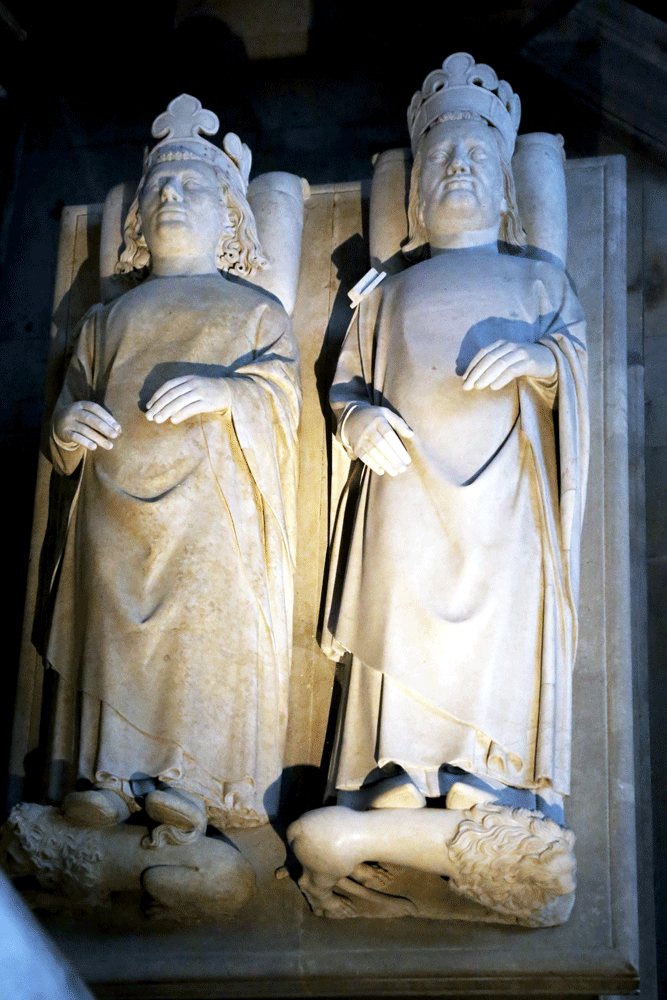 |
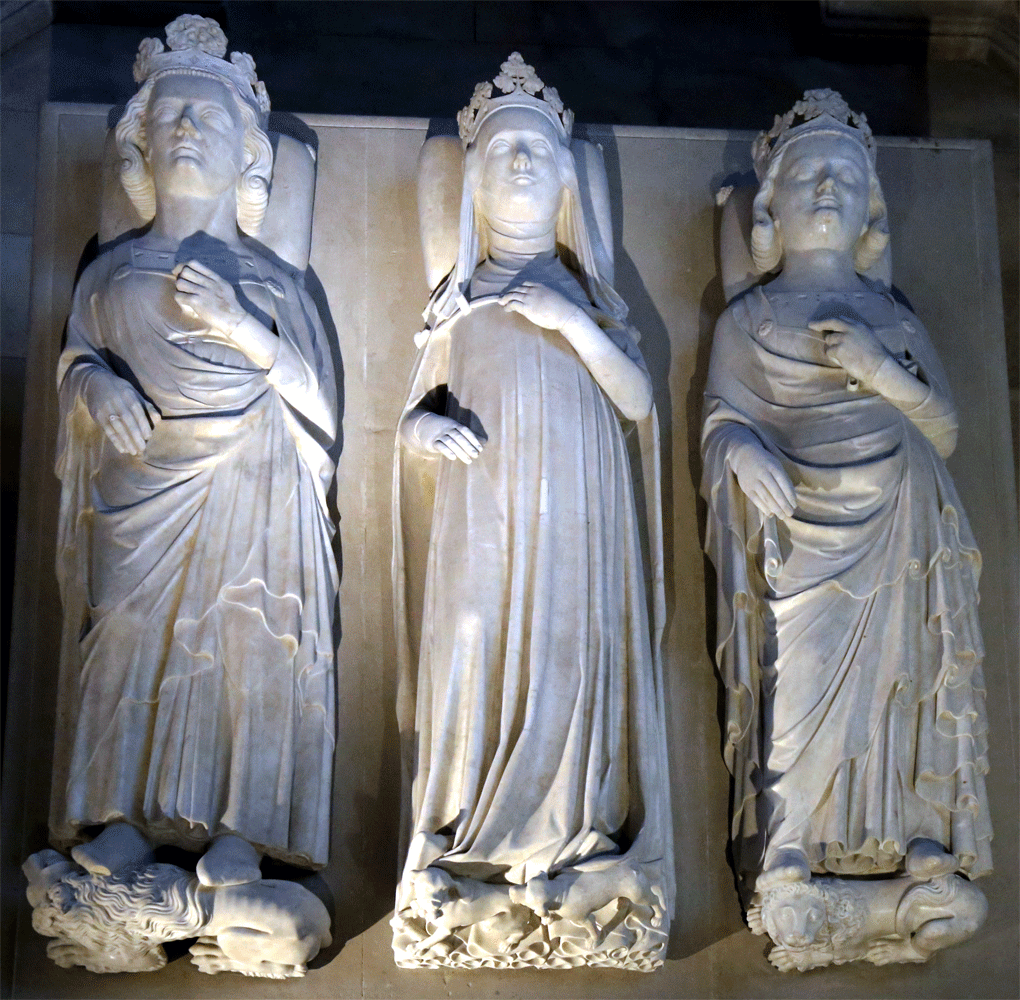 |
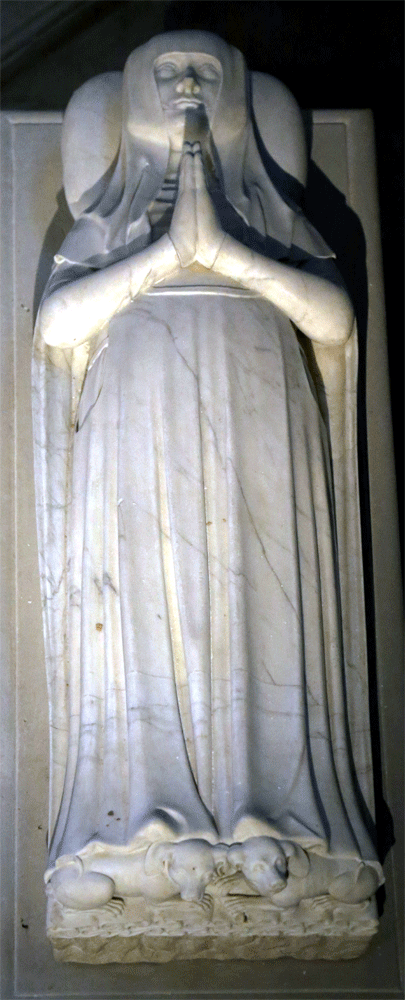 |
|||
| Philip VI 'Of Valois' (1293 - 1350) Following the death of the sons of Philip IV ('The Fair) - all of who died childless - the crown passed to the Valois branch of the Capetians; Edward III of England believed he had a better claim to the throne of France. |
John II 'The Good' ( 1319 - 1364) Son of Philip VI. He was captured at the Battle of Poiters in 1356 by the English . He was allowed to return to France, leaving his son behind as a hostage; he however escaped and John returned to England where he died. |
Philip V 'The
Long' (1293 - 1322) Son of Philip IV |
Jeanne d'Evreux (1371) Third wife of Charles IV. |
Charles IV 'The
Fair' (1295 - 1328) Son of Philip IV |
Blanche of France (1328 - 1393) Daughter of Charles IV Wife of Philip of Orléans. From the workshop of Jean de Liège and Robert Loisel |
| These two monuments were sculptured by a team of sculptors led by André Beauneuveu (1366) | Dated 1327 | The Queen became a patron of the arts following her husband's death and commisioned her effigy during her life time. | Dated c. 1329 | ||
With the accession of the Valois kings there is a change of style: the cloak is attached at the shoulder, the crown has four points and one hands holds the scepter and the other the hand of justice. These latter are unfortunately lost from these effigies but can be seen on the later examples. Note the open cloaks and the position of the hands, which is also featured on the effigies of Philip III, father of Philip IV, and Charles X, another brother of the above two brother kings... |
|||||
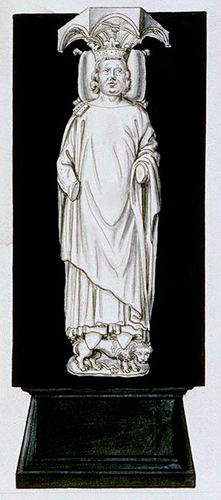 |
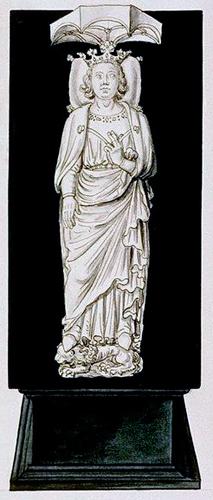 |
|||
| Philip VI Of Valois |
Charles IV The Fair |
| Henry II & Catherine of Medici |
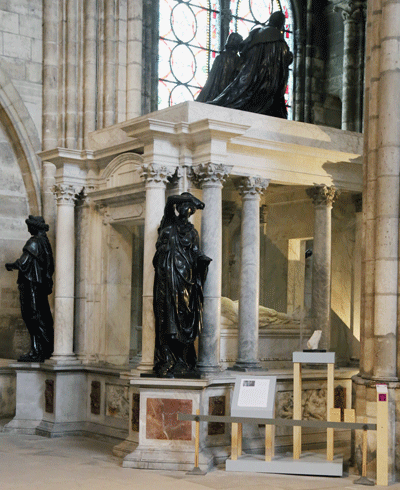 |
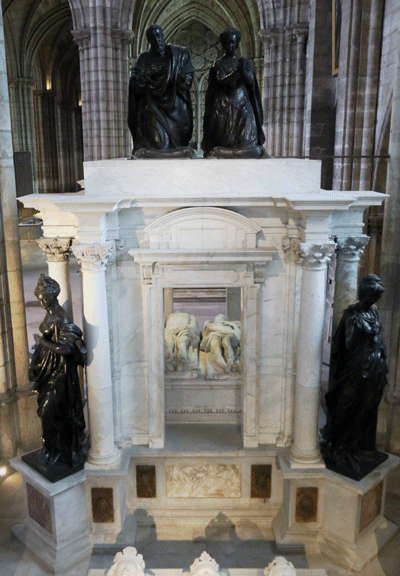 |
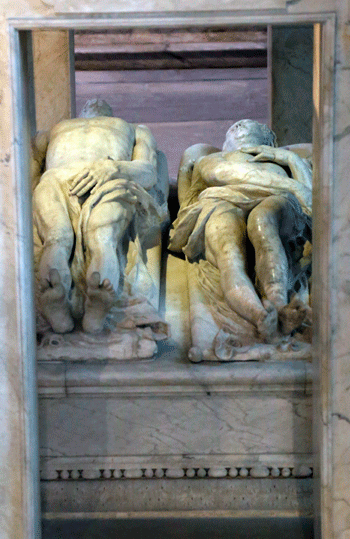 |
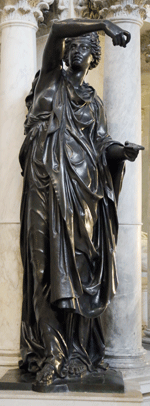 |
 |
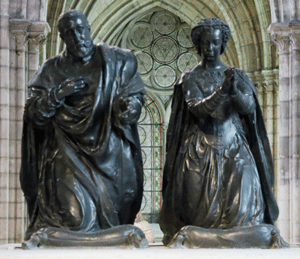 |
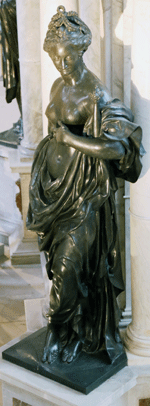 |
awaiting 4th photograph |
| Henry II (1519 - 1559) and Catherine of Medici (1519 - 1589) (Tomb) The day after her husband was accidentally killed in a tournament, Catherine of Medici decided to erect a funerary monument for herself and Henry. She requested Francesco Primaticcio to design and oversee the project and he appointed Germain Pilon as sculptor. It was completed in 1570. |
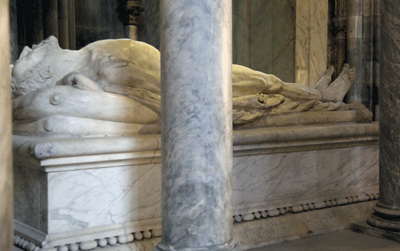 |
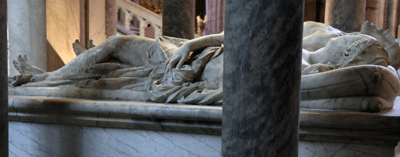 |
| A similar design was
used for this monument as had been used for the previous two
monarchs: the King and Queen lie on their tomb chests are
cadavers while on top the kneel in prayer. These latter figures
are in bronze as are the Four Virtues - Faith, Hope, Charity,
and Good Deeds at the corners. The monument was originally situaed in the 'Mausoleum of the Valois', discussed earlier. |
| Guillaume du Chastel |
 |
| Guillaume du Chastel (1441) was pantler (the servant in charge of the of food and the pantry in a household) and to honour him, King Charles VII requested his burial in Saint-Denis, as he and his father had with their constables (head of the army). The body is of stone but the face of marble. |
| Louis XII & Anne of Brittany |
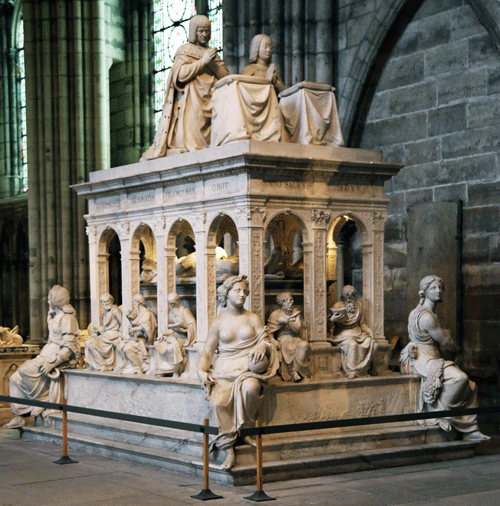 |
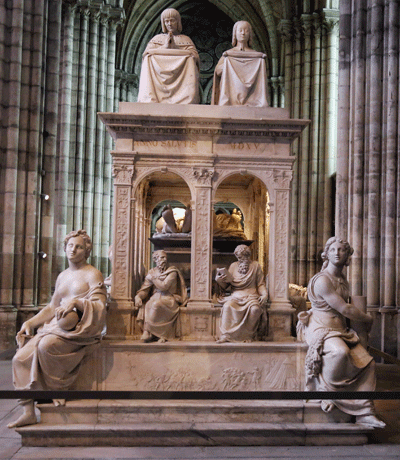 |
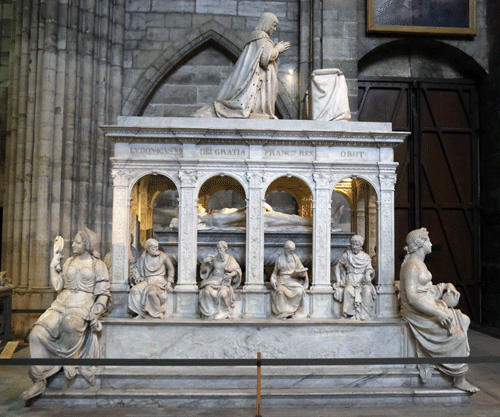 |
|
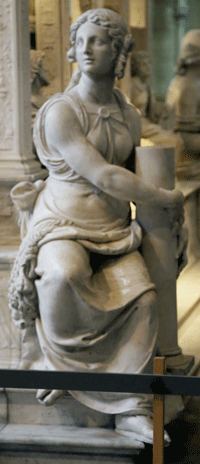 |
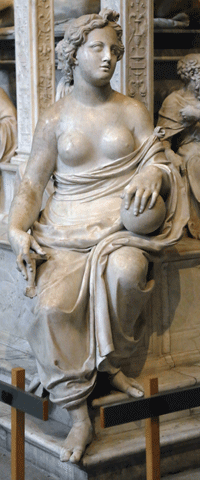 |
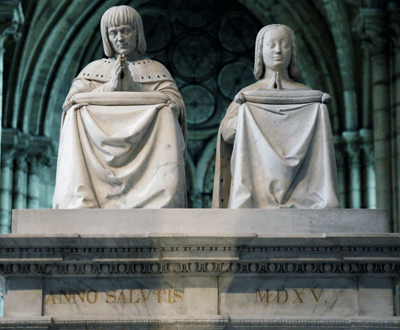 |
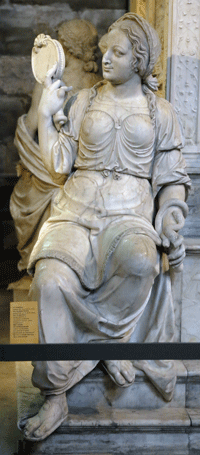 |
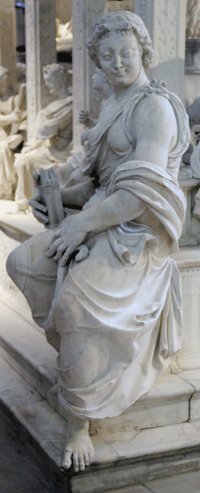 |
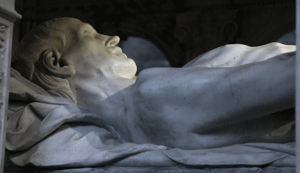 |
Louis XII (1462 - 1515) & Anne
of Brittany (1477 - 1514) In 1516 Francis I commissioned a marble monument for his predecessor and this was installed in Saint-Denis in 1531. The designer was either Guido Mazzoni or Perreal and executed by Jean Juste and his family. The base is carved with narrative bas reliefs of the King's Italian wars, and the Four Cardinal Virtues - Prudence, Temperance, Fortitude, and Strength sit at the corners. Figures of the Apostles sit under the arches. The King and Queen lie on their tomb chest inside the monument, shown as cadavers, rather grimly shown at the moment of death, the Queen throwing back her head in a final spasm. The post mortem sutures are gruesomely shown. On the upper stage the King and Queen kneel in prayer. |
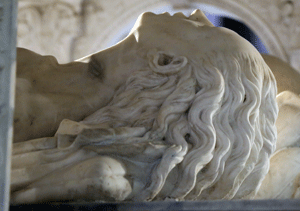 |
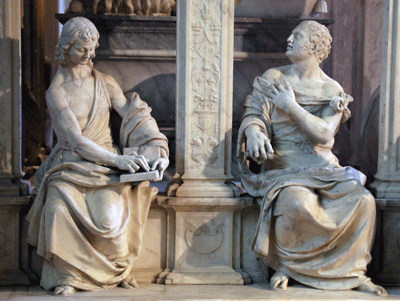 |
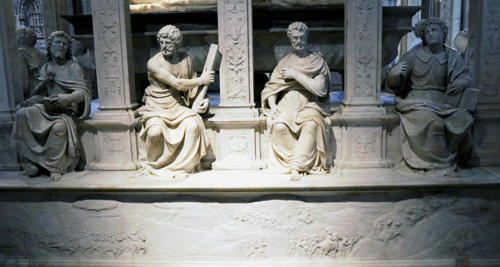 |
| Monuments Situated Along the South Aspect of the
North Transept Mainly medieval and originally in Saint-Denis |
 |
 |
 |
 |
|
Top:
Carloman (751 - 771) Son of Pépin, brother of
Charlemagne. Originally buried in Reims but reburied in St Denis
in the 13th century. Bottom: Ermentrude (825 - 869) Wife of Charles II 'the Bald'. See also below |
Top: Philip of
France (1116 -1131) Son of Louis the Fat. He was
crowned in his father's lifetime but died before his father.. Bottom: Constance of Castile (1136 - 1160) Second wife of Louis VII, The Young. Note the book she holds. See also below |
| The above effigies, and those in the first row below are of stone and part of the 'Saint Louis Series', dating from 1263 - 1264 | |
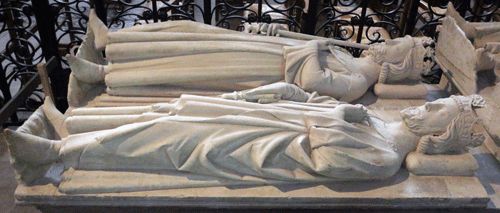 |
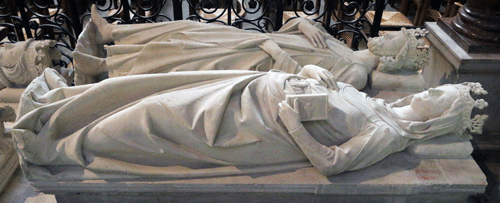 |
| Top:
Louis VI
The Fat (1080 - 1137) Bottom: Henry I (1008 - 1060) |
Top:
Robert II The Pious (970 -
1031) Bottom: Constance of Arles (984 - 1031) Third wife of Robert the Pious. Note that she holds a book in the opposite hand to the of Constance of Castile, above. |
 |
 |
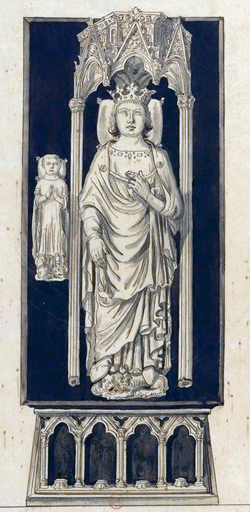 |
 |
Left Top:
John I
The Posthumous (1316)
Aged five days. Marble, Son of Louis X
'Le Hutin' and Clémence of
Hungary, his second wife. He died five months and four days
after the death of his father, and was succeeded by his uncle -
Philippe V - who had acted as regent and was accused of being
responsible for the child's death. Left Bottom: Jeanne of France (1131 - 1349) Marble, first half of 14th century. Queen of Navarre and only daughter of Louis X 'LeHutin' & his first wife Margaret of Burgundy. Above: Louis X 'Le Hutin' (1289 - 1316) Marble c. 1327. He was first married to Margaret of Burgundy, who was later accused of adultery and strangled in prison. He later married Clémance of Hungary. See also below Right: The drawing from around 1700 shows that the effigies of Louis X and that of his son John I were originally placed on the same tomb chest. |
|
| Some Effigies from Above | |||||
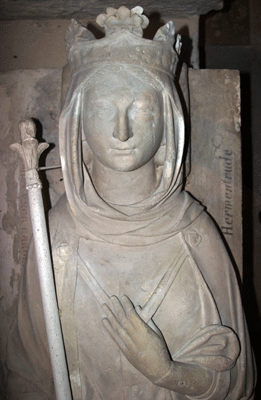 |
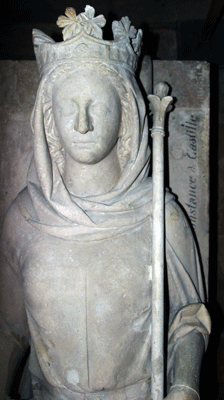 |
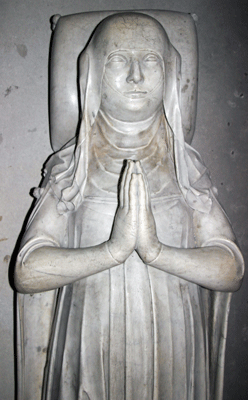 |
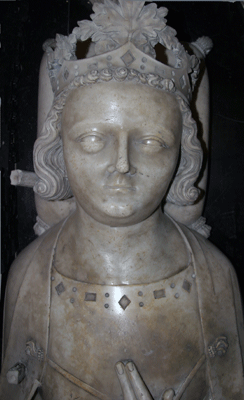 |
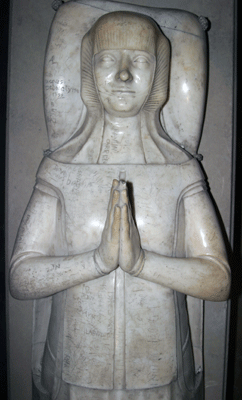 |
|
| Ermentrude | Constance of Castile | Blanche of France | Louis X 'The Hutin' | Marguerite of Flanders | |
 |
 |
 |
 |
 |
|||
|
Far left: Louis, Cardinal of Bourbon (1493 - 1557) Son of François, Count of Vendôme. The marble column was sculpted by Jacques de Valleroy and originally held a kneeling copper effigy of the Cardinal. The Wikipedia entry states that he was buried in the cathedral of Laon, so this is part of a cenotaph.. Near left: Henry III (1574 - 1589) & Louise of Lorraine ( - 1650) Henry III, heart burial, was assassinated at Saint-Cloud where his heart was buried, his body being taken to the Abbey of Saint-Corneille, Saint-Denis then being in the hands of the 'Leaguers'; he was finally buried at Saint-Denis in 1610 in the vault of his father, Henry II. Provenance: Collegiate Church of Saint-Cloud. Above top: Charles d'Evreux, Count of Etampes (1305 - 1336) Son of Louis d'Evreaux and Marguerite d' Artois. Hence grandson of Philippe III. Marble; first part of 14th century. Very fine. See also below Provenance: Convent of the Cordeliers Above bottom: Marguerite of Flanders (1310 - 1382) Daughter of Philip V and wife of Louis II of Flanders. who was killed at the Battle of Crécy. Marble, latter part of 14th century. Also see above. Right: Béatrice de Bourbon ( - 1383) Daughter of Duke Louis I of Bourbon and wife of John of Luxembourg, King of Bohemia. Her tomb had two effigies: one recumbent, no longer extant, and this standing effigy of limestone, showing her wearing the crown of Bohemia. Provenance: Convent of the Jacobins, Paris |
| Monuments Situated in the West Part of the North Transept, Brought from Other Churches |
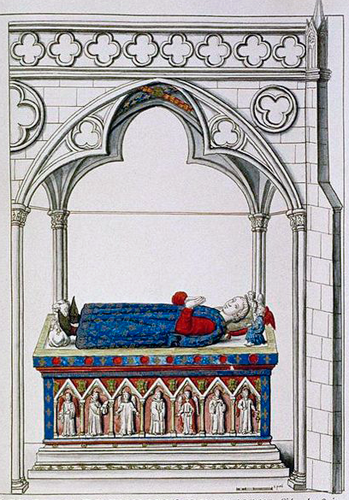 |
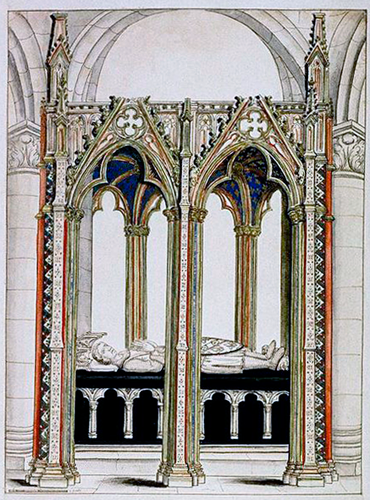 |
||
| Philippe of France (1222-1235) | Charles of Evreux (1305 - 1336) |
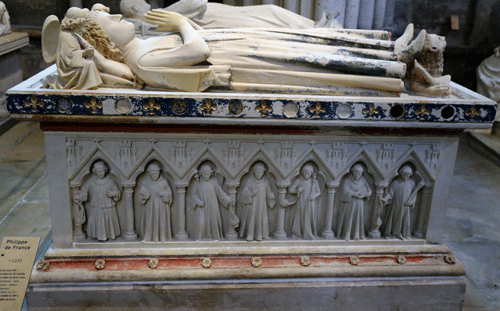 |
 |
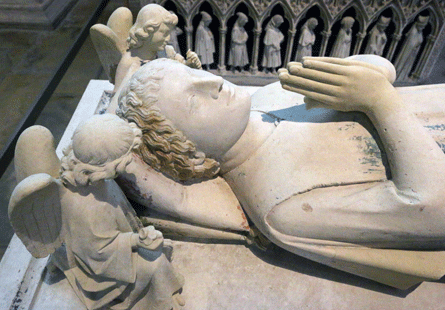 |
| Above:
Philippe of France (1222 - 1235)
Son of Louis VIII and Blanche of Castile The tomb chest is a copy of the original, which is in the Louvre. The weepers around the tomb chests are copied based on fragments of the originals. See also above. Provenance: Royaumont Abbey Below: Louis of France (1260) Son of Saint Louis IX. On this occasion the tomb chest is original: note the funeral procession being portrayed. Provenance: Royaumont Abbey |
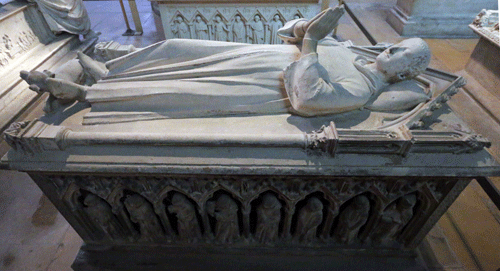 |
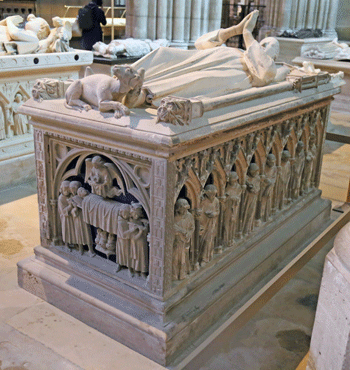 |
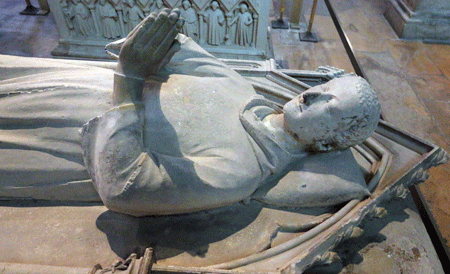 |
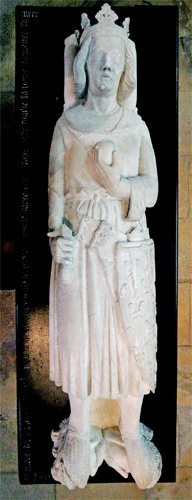
|
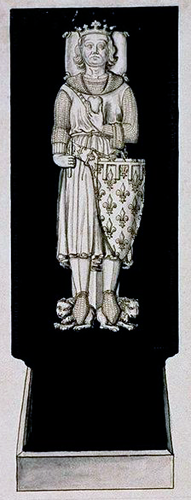 |
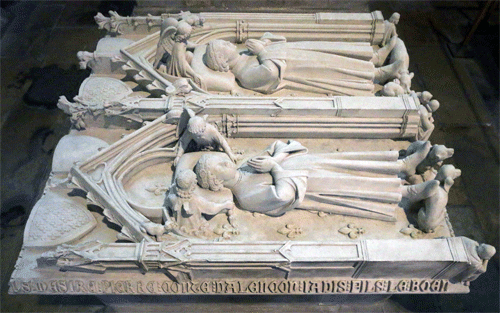 Above Top & Right: Louis & Philip (1271), infant sons of Count of Alençon, fifth son of Saint Louis These effigies are copies, the originals bring in the Museum of the Middle Ages, Paris Provenance: Royaumont Abbey  Above Bottom: Blanche (1253 - 1321) Daughter of St Louis. Born in Jaffa, during her father's crusade. She took the veil in 1275. Stone 14th Century. Also See Above. Provenance: Convent of the Cordeliers |
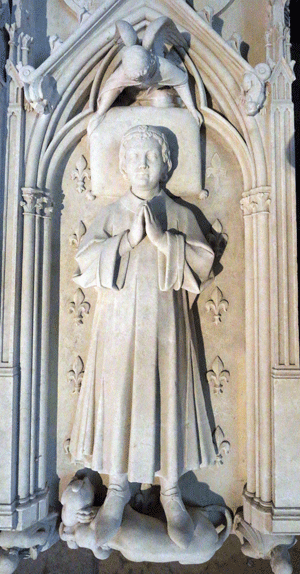 |
|
Charles 1st of Anjou
(1226-1285) Count of Anjou and King of Naples & Sicily Son of Louis VIII. He was expelled from Sicily following a revolt against French rule, known as the 'Sicilian Vespers. His body was buried in Naples but his heart in Paris. This heart burial was ordered in 1326 by Clemence of Hungary, his great granddaughter. Provenance: Church of the Jacobins, Paris |
|||
 |
 |
| Above:
Charles,
Count of Valois (1270-1325) Son of Philip III. Provenance: Church of the Jacobins, Paris.
Marble. Also Below Left. Right Top: Blanche of Evreux-Navarre (1332-1398) Second wife of Philip VI. Marble by Jean de Liège 1371. Also Below Centre. Right Bottom: Jeanne of France (1350 - 1371) Daughter of Philip VI. Marble by Jean de Liège 1371. She originally wore a metal crown. Identical hair style to that of Marie d'Espagne She died on her journey to Spain to marry John of Aragon. Also Below Right. The effigies of Blanche and Jeanne shared the same base, assumed to be by Jean de Liège. See below, far right |
 |
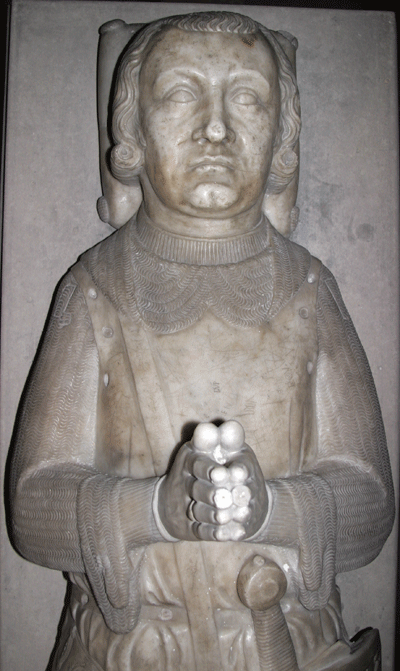 |
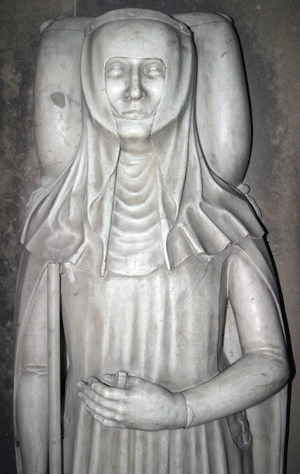 |
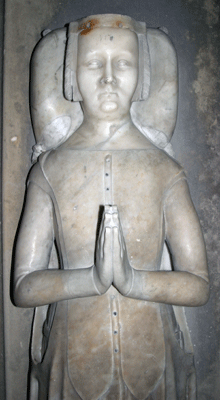 |
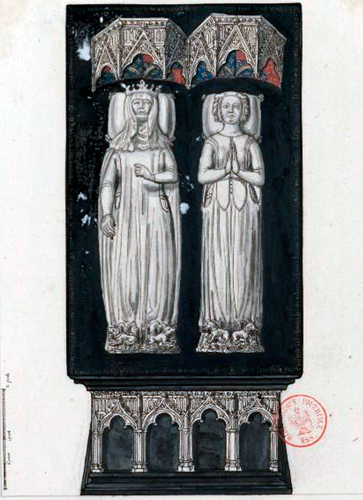 |
| Charles of Valois (1325) | Blanche of Nevarre (1398) | Jeanne of France (1371) | Blanche of Nevarre & Jeanne of France |
 |
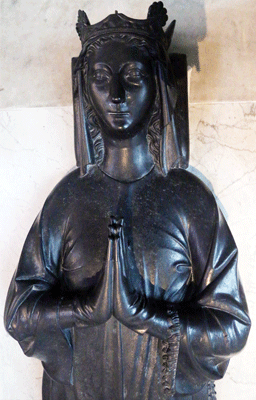 |
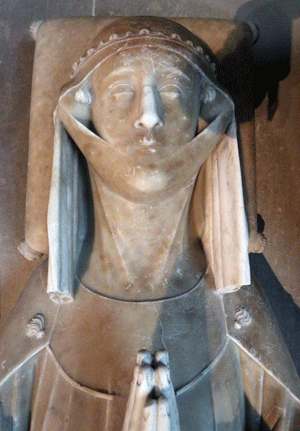 |
 |
||
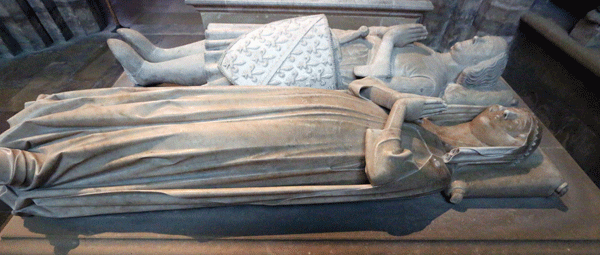 |
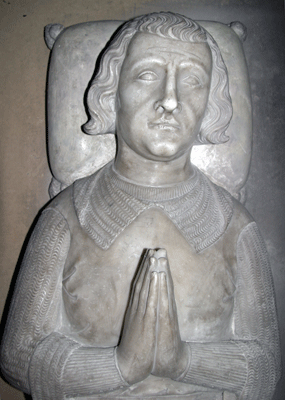 |
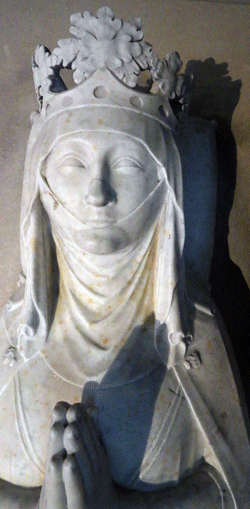 |
 |
Left Column from Top Downward: 1. Black Turnai Marble queen, possibly Marie de Brienne (1225 - 1280), the last Latin empress of Constantinople. Late 13th century. Provenance: Abbey of Maubisson. Also Right Top Left. 2. Louis of France, Count of Evreux (1275 - 1319) Son of Philip III (The Bold). Marble, 1st part of 14th century. Provenance: Church of the Jacobins, Paris Also Right Bottom Left. 3. Marguerite of Artois (1311) Daughter of Philip of Artois; wife of Louis of France. Marble, 1st part of 14th century. Provenance: Church of the Jacobins, Paris Also Right Top Right 4. Clémence of Hungary (1293-1328) Daughter of Charles I of Hungary; second wife of Louis X (leHuntin). Also Right Bottom Left |
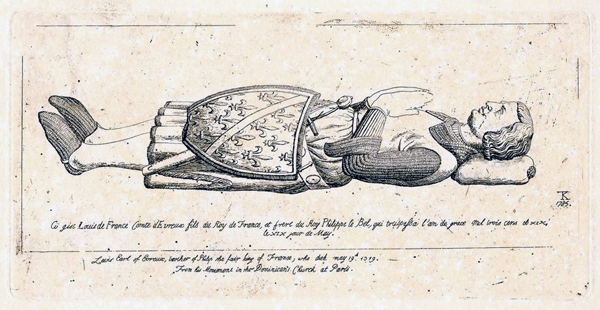 |
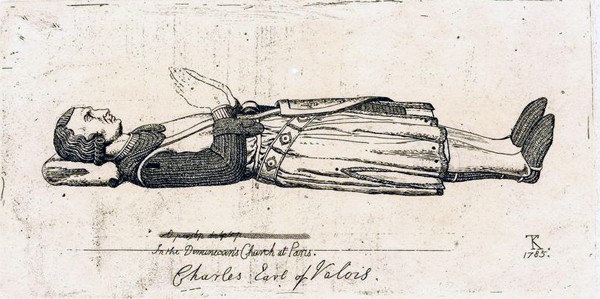 |
| Drawing by Thomas Kerrich (1748-1828) of the effigy of Louis of France. (see above) The text written in French and English states it was executed in Dominican Church, Paris. The drawing is remarkably accurate and this artist influenced Charles Stothard. | Charles, Count of Valois (1270-1325) Son of Philip III. Another drawing by Thomas Kerrich. English text which states it of from the Dominicans' Church, Paris. Very similar to that on the left but slight differences |